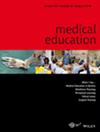Immersive virtual reality training: Addressing challenges and unlocking potentials
Abstract
Background
Simulation-based training has significantly improved healthcare professionals' skills and patient outcomes. Immersive virtual reality is gaining attention in this field and offers potential educational benefits. However, little is known about how key stakeholders in simulation-based training and debriefing receive a complex intervention like immersive virtual reality. This study explores the enablers, barriers and applied debriefing strategies involved in using immersive virtual reality in simulation-based training.
Methods
We purposefully sampled simulation centre directors, course leaders and researchers within debriefing, simulation-based emergency training and immersive virtual reality. First, they observed and debriefed an online immersive virtual reality-based emergency training. Then, they participated in an individual semi-structured interview that was audio recorded and transcribed. We coded and analysed the data based on a reflexive thematic analysis method with a constructionist framing, guided by normalisation process theory as a theoretical lens. All co-authors informed and validated the identified themes.
Results
We conducted 10 individual semi-structured interviews and generated five main themes on factors that supported or impeded the normalisation of immersive virtual reality for simulation-based training: understanding, engagement, strategies in action, appraisal and psychological safety.
Discussion
Immersive virtual reality contains unique challenges and potential for simulation-based training. Its strengths and limitations should be carefully considered in relation to learning goals, the target group and context. This study explored the advantages and disadvantages of various immersive virtual reality features in relation to different learning objectives and proposed practical strategies for enhancing learning in immersive virtual reality simulation-based training.


 求助内容:
求助内容: 应助结果提醒方式:
应助结果提醒方式:


